9.5: Exercises
- Page ID
- 25442
9.5.1: Analysis Problems
1. For the circuit of Figure \(\PageIndex{1}\), determine compliance, \(P_{load(max)}\), \(P_{D(max)}\), \(BV_{CEO}\) and \(I_{C(max)}\). \(V_{CC}\) = 15 V, \(V_{EE}\) = −15 V, \(\beta\) = 75, \(R_L\) = 16 \(\Omega\), \(R_1\) = 680 \(\Omega\), \(R_2\) = 680 \(\Omega\).
2. For the circuit of Figure \(\PageIndex{1}\), determine \(Z_{in}\). \(V_{CC}\) = 15 V, \(V_{EE}\) = −15 V, \(\beta\) = 75, \(R_L\) = 16 \(\Omega\), \(R_1\) = 680 \(\Omega\), \(R_2\) = 680 \(\Omega\).
3. For the circuit of Figure \(\PageIndex{1}\), determine \(Z_{in}\). \(V_{CC}\) = 25 V, \(V_{EE}\) = −25 V, \(\beta\) = 70, \(R_L\) = 8 \(\Omega\), \(R_1\) = 560 \(\Omega\), \(R_2\) = 560 \(\Omega\).
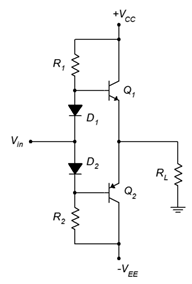
Figure \(\PageIndex{1}\)
4. For the circuit of Figure \(\PageIndex{1}\), determine compliance \(P_{load(max)}\), \(P_{D(max)}\), \(BV_{CEO}\) and \(I_{C(max)}\). \(V_{CC}\) = 25 V, \(V_{EE}\) = −25 V, \(\beta\) = 70, \(R_L\) = 8 \(\Omega\), \(R_1\) = 560 \(\Omega\), \(R_2\) = 560 \(\Omega\).
5. For the circuit of Figure \(\PageIndex{2}\), determine \(P_{load(max)}\), \(P_{D(max)}\), \(BV_{CEO}\) and \(I_{C(max)}\). \(V_{CC}\) = 15 V, \(\beta\) = 75, \(R_L\) = 16 \(\Omega\), \(R_1\) = 630 \(\Omega\), \(R_2\) = 630 \(\Omega\).
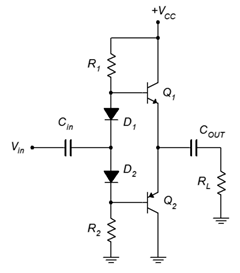
Figure \(\PageIndex{2}\)
6. For the circuit of Figure \(\PageIndex{2}\), determine \(Z_{in}\). \(V_{CC}\) = 15 V, \(\beta\) = 75, \(R_L\) = 16 \(\Omega\), \(R_1\) = 630 \(\Omega\), \(R_2\) = 630 \(\Omega\).
7. For the circuit of Figure \(\PageIndex{2}\), determine \(Z_{in}\). \(V_{CC}\) = 25 V, \(\beta\) = 70, \(R_L\) = 8 \(\Omega\), \(R_1\) = 560 \(\Omega\), \(R_2\) = 560 \(\Omega\).
8. For the circuit of Figure \(\PageIndex{2}\), determine \(P_{load(max)}\), \(P_{D(max)}\), \(BV_{CEO}\) and \(I_{C(max)}\). \(V_{CC}\) = 25 V, \(\beta\) = 70, \(R_L\) = 8 \(\Omega\), \(R_1\) = 510 \(\Omega\), \(R_2\) = 510 \(\Omega\).
9. For the circuit of Figure \(\PageIndex{3}\), determine \(P_{load(max)}\), \(P_{D(max)}\), \(BV_{CEO}\) and \(I_{C(max)}\) for the output transistors. \(V_{CC}\) = 24 V, \(V_{EE}\) = −24 V, \(\beta\) = 75, \(R_L\) = 8 \(\Omega\), \(R_1\) = 2.5 k\(\Omega\), \(R_2\) = 300 \(\Omega\), \(R_3\) = 330 \(\Omega\), \(R_4\) = 63 \(\Omega\).
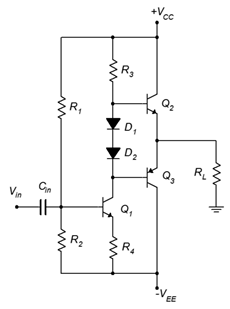
Figure \(\PageIndex{3}\)
10. For the circuit of Figure \(\PageIndex{3}\), determine \(A_v\) and \(Z_{in}\). \(V_{CC}\) = 24 V, \(V_{EE}\) = −24 V, \(\beta\) = 75, \(R_L\) = 8 \(\Omega\), \(R_1\) = 2.5 k\(\Omega\), \(R_2\) = 300 \(\Omega\), \(R_3\) = 330 \(\Omega\), \(R_4\) = 63 \(\Omega\).
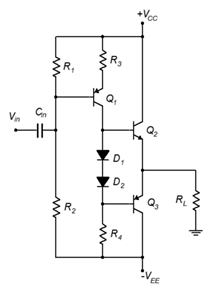
Figure \(\PageIndex{4}\)
11. For the circuit of Figure \(\PageIndex{4}\), determine \(P_{load(max)}\), \(P_{D(max)}\), \(BV_{CEO}\) and \(I_{C(max)}\) for the output transistors. \(V_{CC}\) = 24 V, \(V_{EE}\) = −24 V, \(\beta\) = 75, \(R_L\) = 16 \(\Omega\), \(R_1\) = 600 \(\Omega\), \(R_2\) = 5 k\(\Omega\), \(R_3\) = 63 \(\Omega\), \(R_4\) = 330 \(\Omega\).
12. For the circuit of Figure \(\PageIndex{4}\), determine \(A_v\) and \(Z_{in}\). \(V_{CC}\) = 24 V, \(V_{EE}\) = −24 V, \(\beta\) = 75, \(R_L\) = 16 \(\Omega\), \(R_1\) = 600 \(\Omega\), \(R_2\) = 5 k\(\Omega\), \(R_3\) = 63 \(\Omega\), \(R_4\) = 330 \(\Omega\).
13. Determine the limit current for the circuit of Figure \(\PageIndex{5}\) if \(R_E\) = 0.2 \(\Omega\).
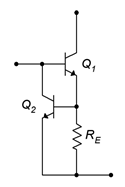
Figure \(\PageIndex{5}\)
14. Determine \(P_{load(max)}\), and \(P_{D(max)}\), \(BV_{CEO}\) and \(I_{C(max)}\) for the output and driver transistors of Figure \(\PageIndex{6}\). \(V_{CC}\) = 50 V, \(V_{EE}\) = −50 V, \(\beta\) = 75, \(R_L\) = 8 \(\Omega\), \(R_5\) through \(R_8\) = 0.05 \(\Omega\). Assume all other components produce proper bias.
9.5.2: Design Problems
15. For the circuit of Figure \(\PageIndex{3}\), determine values for \(R_1\) and \(R_2\) for proper bias. \(V_{CC}\) = 32 V, \(V_{EE}\) = −32 V, \(\beta\) = 75, \(R_L\) = 8 \(\Omega\), \(R_3\) = 330 \(\Omega\), \(R_4\) = 63 \(\Omega\).
16. Determine a value for \(R_E\) to set the limit current for the circuit of Figure \(\PageIndex{5}\) to 2 A.
9.5.3: Challenge Problems
17. For the circuit of Figure \(\PageIndex{6}\), determine values for \(R_1\) and \(R_2\) for proper bias. \(V_{CC}\) = 50 V, \(V_{EE}\) = −50 V, \(\beta\) = 85, \(R_L\) = 8 \(\Omega\), \(R_5\) through \(R_8\) = 0.05 \(\Omega\), \(R_3\) = 2.2 k\(\Omega\), \(R_4\) = 330 \(\Omega\).
18. For the circuit of Figure \(\PageIndex{7}\), determine a value for \(R_5\) for proper bias. \(V_{CC}\) = 30 V, \(V_{EE}\) = −30 V, \(\beta\) = 100, \(R_L\) = 16 \(\Omega\), \(R_1\) = 2.2 k\(\Omega\), \(R_2\) = 8.2 k\(\Omega\), \(R_3\) = 1.2 k\(\Omega\), \(R_4\) = 47 \(\Omega\), \(R_5\) = 330 \(\Omega\), \(R_6\) = 470 \(\Omega\), \(R_7\) = 68 \(\Omega\).
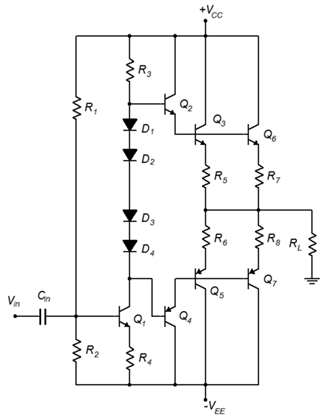
Figure \(\PageIndex{6}\)
9.5.4: Computer Simulation Problems
19. Perform a transient analysis on the circuit of Problem 1 to verify the compliance.
20. Perform a transient analysis on the circuit of Problem 4 to verify the compliance.
21. Perform a DC analysis on the design from Problem 15 to verify the results.
22. Perform a DC analysis on the design from Problem 17 to verify the results.
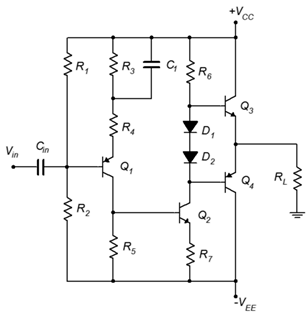
Figure \(\PageIndex{7}\)


